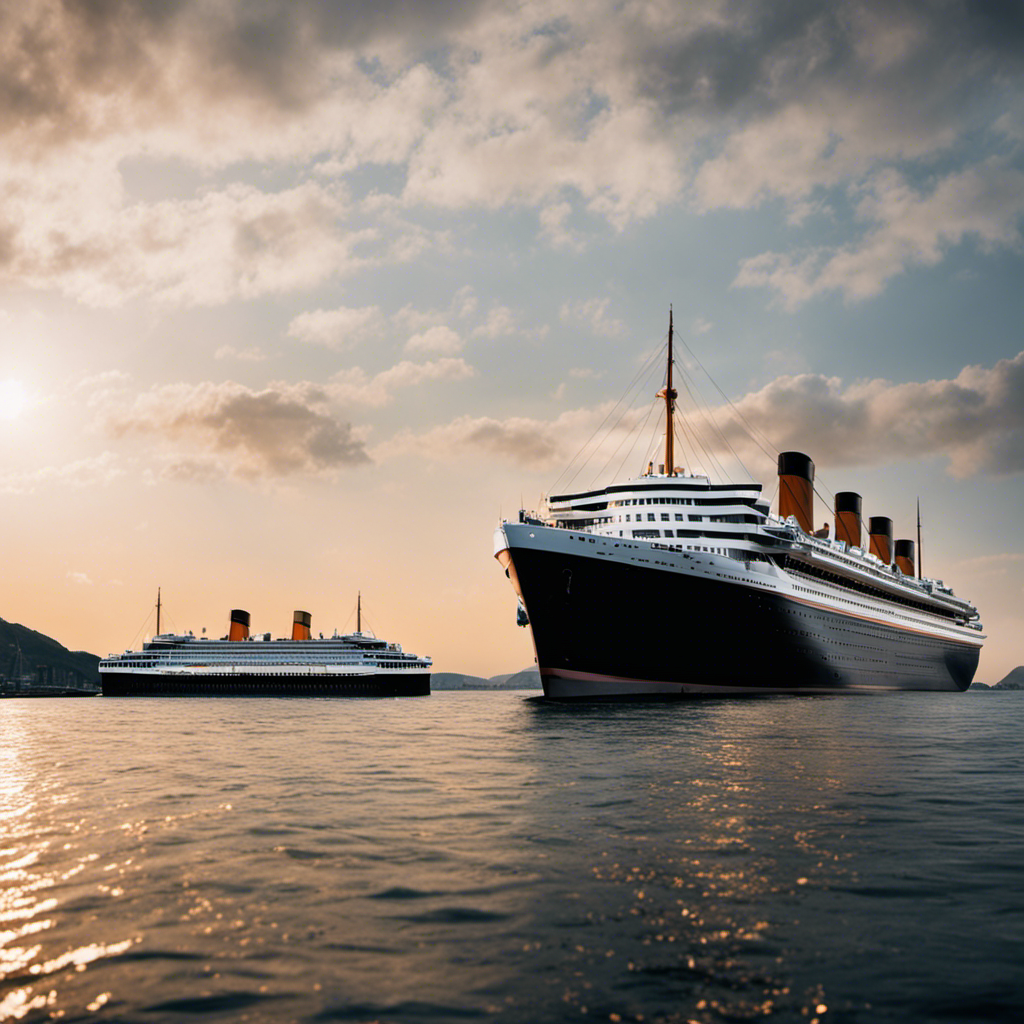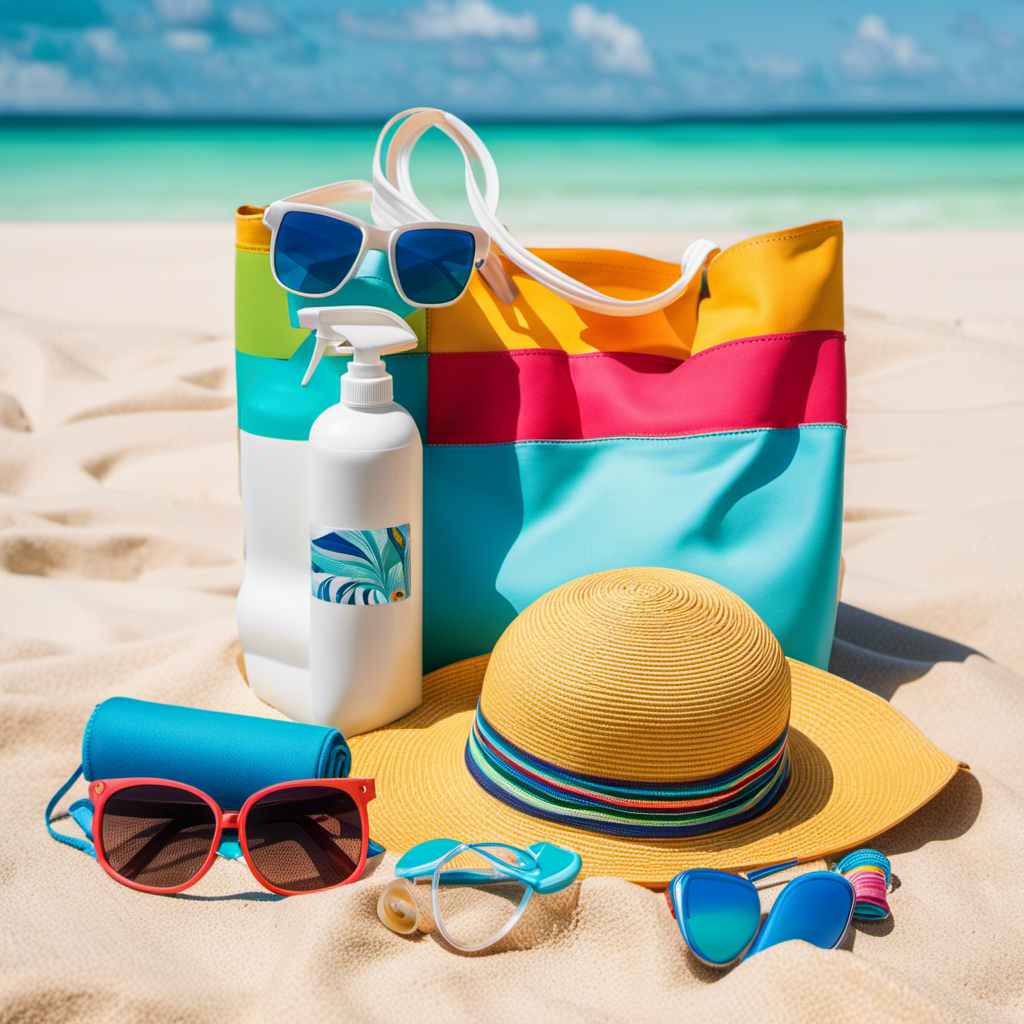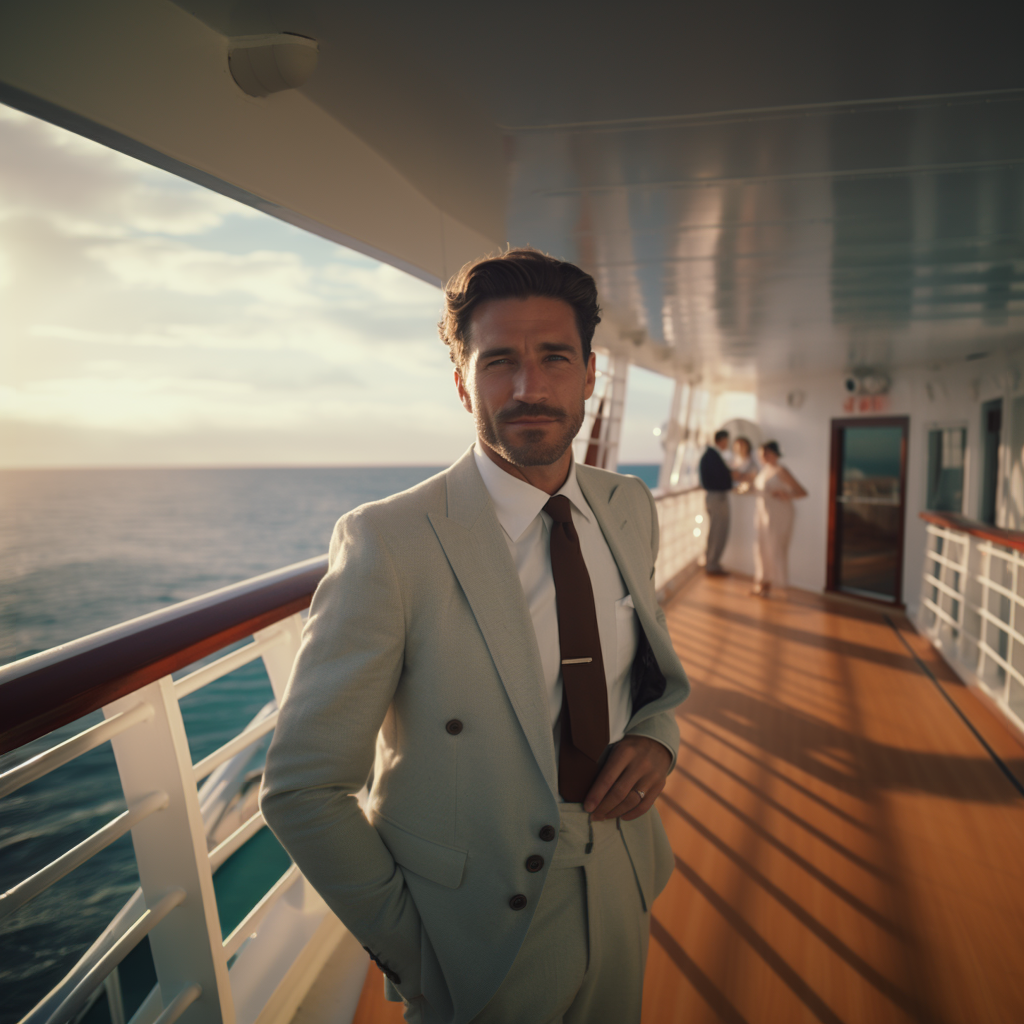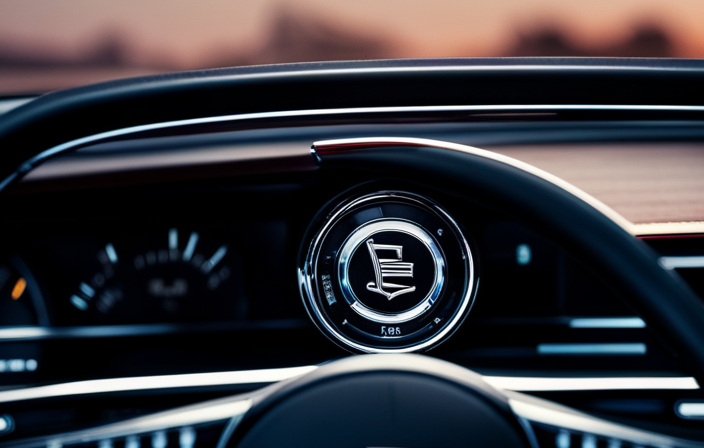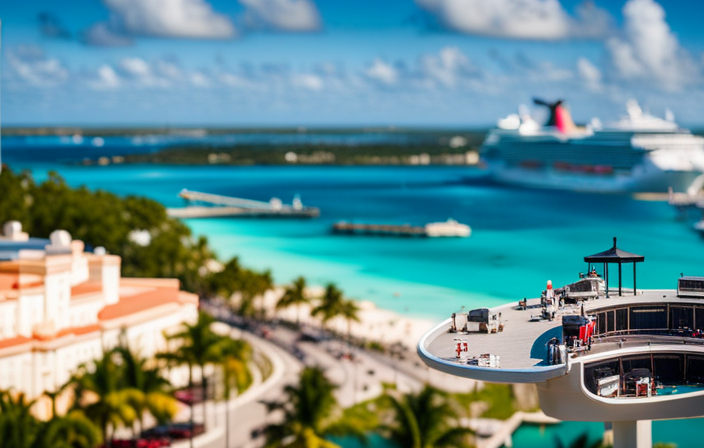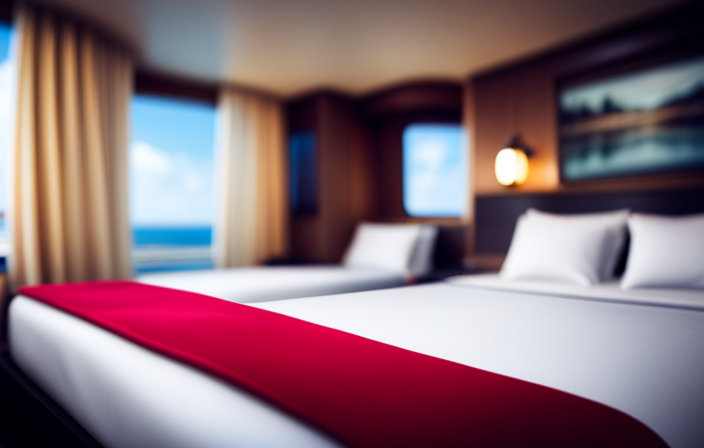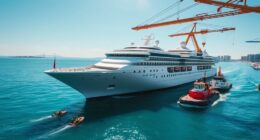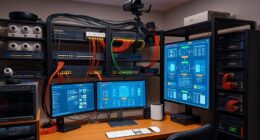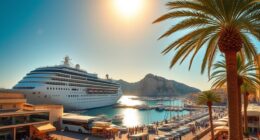Delving into maritime history, I find myself completely fascinated by the enormity of the Titanic. This iconic vessel, once hailed as the epitome of luxury and grandeur, has always captivated my interest.
Now, as I compare its size to modern cruise ships, I am struck by the stark differences and advancements in technology. Join me on this journey as we explore the dimensions, passenger capacity, weight, speed, amenities, and safety of these magnificent vessels.
Key Takeaways
- The Titanic was approximately 882 feet long and weighed around 46,328 tons, much smaller than modern cruise ships.
- Modern cruise ships can stretch over 1,000 feet long and weigh over 200,000 tons, surpassing the size and scale of the Titanic.
- The modern cruise ship industry has made significant innovations in sustainable energy solutions, waste management systems, advanced propulsion systems, and water conservation measures.
- Modern cruise ships like Symphony of the Seas are much larger than the Titanic, measuring 1,188 feet in length and 215 feet in width, and can accommodate thousands of passengers, compared to the Titanic’s capacity of approximately 2,435 passengers and crew members.
The Titanic: An Iconic Ship of the Past
The Titanic’s size was impressive for its time, but it is much smaller compared to modern cruise ships. As an iconic ship of the past, the Titanic holds great historical significance.
It was a marvel of engineering, measuring approximately 882 feet long and weighing around 46,328 tons. With its grandeur and luxurious amenities, the Titanic represented the epitome of luxury travel in the early 20th century.
However, when we compare the Titanic’s size to modern cruise ships, it pales in comparison. Today’s cruise ships can stretch over 1,000 feet long and weigh over 200,000 tons. These behemoths of the sea can carry thousands of passengers and offer an array of entertainment, dining, and recreational options.
The modern cruise ship industry has undoubtedly grown into a giant, surpassing the Titanic in both size and scale.
The Modern Cruise Ship Industry: A Growing Giant
With the cruise ship industry constantly expanding, it’s hard to imagine the immense size of these modern giants. As someone who has always been fascinated by ships, I am amazed by the innovative features and advancements that have been incorporated into these floating cities. Here are some remarkable modern cruise ship innovations that have left a lasting impact on me:
-
Sustainable energy solutions: Many cruise ships now utilize advanced technologies like solar panels and wind turbines to reduce their environmental footprint.
-
Waste management systems: These ships have implemented sophisticated waste management systems to minimize pollution and promote recycling.
-
Advanced propulsion systems: Modern cruise ships are equipped with state-of-the-art propulsion systems that not only increase efficiency but also reduce carbon emissions.
-
Water conservation measures: To combat water scarcity, these ships have implemented water-saving technologies and practices.
The environmental impact of these innovations cannot be overstated. They have revolutionized the cruise ship industry, making it more sustainable and eco-friendly.
Now let’s dive into the dimensions: length and width comparison of these massive vessels.
Dimensions: Length and Width Comparison
As the cruise ship industry continues to grow, it’s fascinating to explore the dimensions of these massive vessels. When it comes to length comparison, the Titanic, which was once considered the largest ship in the world, measured 882 feet from bow to stern.
In comparison, modern cruise ships have far surpassed this length. The Symphony of the Seas, currently the world’s largest cruise ship, measures an astonishing 1,188 feet.
Moving on to width comparison, the Titanic had a width of 92 feet. In contrast, the Symphony of the Seas boasts a width of 215 feet, almost two and a half times wider than the Titanic.
It’s incredible to see how much these ships have evolved in terms of size and proportions over the years. Speaking of proportions, another important aspect to consider is the passenger capacity: how many people can each ship accommodate?
Passenger Capacity: How Many People Can Each Ship Accommodate?
When comparing the passenger capacity of the Titanic to modern ships, there are significant size differences to consider.
The Titanic had a maximum capacity of approximately 2,435 passengers and crew members, with accommodations for first, second, and third class passengers.
In contrast, modern cruise ships can accommodate thousands of passengers, with some of the largest ships able to hold over 6,000 passengers and crew members.
Titanic Vs. Modern Ships: Comparison
The Titanic is significantly smaller than modern cruise ships. When comparing the size of the Titanic to modern ships, it becomes evident that architectural design advancements have played a significant role in the evolution of cruise ships. Here are four key points to consider:
-
Length: The Titanic measured approximately 882 feet in length, while modern cruise ships can exceed 1,000 feet, showcasing a substantial increase in size.
-
Width: The Titanic had a width of about 92 feet, whereas modern ships can be almost 150 feet wide, allowing for more spacious accommodations and amenities.
-
Height: The Titanic stood at around 175 feet tall, while modern ships can reach heights of over 200 feet, providing more deck space for recreational activities.
-
Gross Tonnage: The Titanic had a gross tonnage of around 46,000 tons, while modern cruise ships can exceed 200,000 tons, demonstrating a remarkable growth in capacity.
As we delve into the section about passenger capacity and size differences, it becomes apparent how these size disparities have affected the ability to accommodate more passengers.
Passenger Capacity: Size Differences
Now let’s delve into the passenger capacity of the Titanic compared to modern cruise ships.
When it comes to size, the Titanic was certainly impressive, but how many people could it actually accommodate? The Titanic had a maximum capacity of around 3,547 passengers and crew members. This was considered quite large for its time.
However, when we look at modern cruise ships, we see a significant increase in passenger capacity. For example, the Symphony of the Seas, the world’s largest cruise ship, can carry up to 6,680 passengers. This substantial difference in passenger capacity highlights the advancements in shipbuilding and design over the years.
When considering the size of these ships, it’s also important to analyze the cost and environmental impact. Modern cruise ships are not only larger in terms of passenger capacity, but they also come with a hefty price tag. The cost of constructing and maintaining these massive vessels is significantly higher compared to the Titanic.
Additionally, the environmental impact of modern cruise ships is a growing concern. These ships require a tremendous amount of fuel to operate, and their emissions contribute to air and water pollution. As a result, cruise companies are now investing in eco-friendly technologies to mitigate their environmental impact.
With the passenger capacity and size differences in mind, let’s now move on to the next section: weight and displacement – how heavy are these vessels?
Weight and Displacement: How Heavy Are These Vessels?
Cruise ships today are significantly heavier than the Titanic. When comparing the weight of these vessels, it is important to consider their displacement, which refers to the weight of water displaced by the ship’s hull.
The Titanic had a gross tonnage of around 46,000 tons, while modern cruise ships can weigh upwards of 150,000 tons. This substantial difference in weight can be attributed to advancements in shipbuilding technology and the increasing size of cruise ships to accommodate more passengers and amenities. The increase in weight also allows for improved stability and safety at sea.
Transitioning into the subsequent section about speed and navigation, it is evident that the weight of modern cruise ships has a significant impact on their ability to sail efficiently and maintain high speeds.
Speed and Navigation: How Fast Can They Sail?
To sail efficiently and maintain high speeds, you’ll need to consider the weight and displacement of these massive vessels. The size of a cruise ship plays a crucial role in determining its speed limits and the impact it has on fuel consumption.
Here are some key factors to consider:
- Hull design: A streamlined hull helps reduce drag in the water, allowing the ship to move faster with less resistance.
- Engine power: Modern cruise ships are equipped with powerful engines that generate significant thrust, enabling them to reach impressive speeds.
- Speed limits: Cruise ships typically have speed limits imposed by maritime regulations to ensure safety and minimize environmental impact.
- Fuel consumption: Higher speeds require more fuel, impacting the ship’s overall efficiency and environmental footprint.
Considering these factors, cruise ships must strike a balance between speed and fuel consumption to provide a comfortable and enjoyable experience for passengers while minimizing their impact on the environment. This attention to detail extends beyond speed and navigation to include the amenities and facilities that make cruising a luxurious experience.
Amenities and Facilities: Luxuries on Board
Passengers on board can enjoy a wide range of amenities and facilities, making their cruise experience luxurious and enjoyable. From exquisite dining options to state-of-the-art fitness centers, modern cruise ships offer a plethora of luxury amenities for their guests. Additionally, onboard entertainment is taken to new heights, with theaters showcasing Broadway-style productions, live music performances, and even movie theaters. To give you a visual representation, here’s a table comparing the amenities and facilities on board the Titanic and a modern cruise ship:
| Amenities/Facilities | Titanic | Modern Cruise Ship |
|---|---|---|
| Dining Options | Limited | Numerous |
| Fitness Centers | None | State-of-the-art |
| Theaters | One | Multiple |
| Movie Theaters | None | Available |
As you can see, modern cruise ships offer a wide variety of amenities and facilities, providing a truly luxurious experience for passengers. Now, let’s delve into the technological advances: from steam power to propulsion systems.
Technological Advances: From Steam Power to Propulsion Systems
When it comes to ship propulsion systems, the debate between steam power and modern propulsion systems is a fascinating one.
The introduction of modern propulsion systems has had a significant impact on ship design, allowing for sleeker and more efficient designs. These new systems have also greatly improved the efficiency and speed of ships, enabling them to travel faster and more efficiently than ever before.
Steam Vs. Propulsion Systems
Have you ever wondered how steam propulsion systems in the Titanic compare to modern cruise ships?
The steam propulsion system used in the Titanic relied on the power generated by burning coal to produce steam, which in turn drove the ship’s engines. This system was widely used during the early 20th century but has since been replaced by more advanced propulsion systems in modern cruise ships.
These newer systems, such as diesel-electric or gas turbine engines, are more fuel efficient and have a lower environmental impact compared to the coal-fired steam engines. They are designed to optimize fuel consumption and reduce emissions, making them more environmentally friendly.
This shift in propulsion systems has had a significant impact on ship design and has contributed to the overall evolution of modern cruise ships.
Impact on Ship Design
Imagine how the shift to more advanced propulsion systems has influenced the design of ships. The impact on shipbuilding techniques and environmental considerations cannot be overstated. Here are four ways in which this shift has transformed ship design:
-
Streamlined hulls: With the introduction of advanced propulsion systems, ships are now designed with sleek, streamlined hulls to reduce drag and increase efficiency.
-
Alternative fuels: As environmental concerns grow, shipbuilders are incorporating alternative fuel sources, such as natural gas or hybrid-electric systems, to reduce emissions and minimize the ecological footprint of ships.
-
Noise reduction: Advanced propulsion systems have allowed for quieter ship operations, minimizing the impact on marine life.
-
Improved maneuverability: Modern ships equipped with advanced propulsion systems have enhanced maneuverability, enabling them to navigate through challenging environments with ease.
The shift to more advanced propulsion systems has not only revolutionized ship design, but it has also paved the way for greater efficiency and speed in the maritime industry.
Efficiency and Speed
To maximize efficiency and speed, shipbuilders incorporate advanced propulsion systems and streamlined hull designs. These advancements have greatly improved fuel consumption, reducing the environmental impact of modern ships. By optimizing the shape of the hull and reducing resistance to water flow, ships can glide through the water with less effort, resulting in lower fuel consumption.
Additionally, advanced propulsion systems, such as diesel-electric engines and gas turbines, provide greater power with less fuel usage. This combination of efficient hull designs and propulsion systems has revolutionized the shipping industry, allowing for faster and more fuel-efficient voyages while minimizing the impact on the environment.
Moving forward, shipbuilders continue to explore innovative technologies to further improve efficiency and reduce emissions.
Transition: As shipbuilders strive for efficiency and environmental sustainability, they have also learned important lessons from the tragic sinking of the Titanic.
Safety and Design: Lessons Learned From the Titanic Tragedy
You should consider the safety and design lessons that were learned from the Titanic tragedy.
The sinking of the Titanic in 1912 was a devastating event that resulted in the loss of over 1,500 lives. However, it also led to significant advancements in maritime safety measures.
One of the key lessons learned was the need for sufficient lifeboats for all passengers and crew. The Titanic only had enough lifeboats to accommodate about half of the people on board, which proved to be a fatal oversight. As a result, regulations were put in place to ensure that all ships carry enough lifeboats to accommodate everyone on board.
Additionally, the Titanic’s design flaws, such as the lack of watertight compartments extending high enough, led to the ship sinking faster than anticipated. This highlighted the importance of incorporating watertight compartments that extend higher on modern ships, to prevent rapid flooding and improve overall safety.
Frequently Asked Questions
What Was the Cause of the Titanic’s Sinking?
The cause of the Titanic’s sinking was the impact of an iceberg. A vulnerability assessment revealed that the ship’s design and inadequate safety measures contributed to the disaster.
How Many Lifeboats Were on Board the Titanic?
Lifeboat capacity on the Titanic was inadequate due to outdated regulations. Only 20 lifeboats were on board, enough for only about half of the passengers and crew. This contributed to the high loss of life in the disaster.
What Was the Price of a Ticket on the Titanic?
The ticket cost for the Titanic varied depending on the class of accommodation. First-class tickets could cost up to $4,350 (equivalent to around $120,000 today), while third-class tickets were as low as $36.
How Long Did It Take to Build the Titanic?
The Titanic took approximately three years to build, from 1909 to 1912. The construction process involved thousands of workers and numerous stages, including the laying of the hull and the installation of the interior fittings.
Were There Any Survivors From the Titanic Disaster?
There were survivors from the Titanic disaster, and their stories are both heartbreaking and inspiring. The rescue efforts made by nearby ships were crucial in saving lives, but tragically, many were lost.
Conclusion
In conclusion, the Titanic, a legendary ship of the past, pales in comparison to the colossal modern cruise ships that dominate the industry today. With their immense size, luxurious amenities, and advanced technology, these giants of the sea have truly revolutionized the way we travel.
From the lessons learned from the Titanic tragedy, safety and design have been prioritized, ensuring the well-being of passengers.
As we marvel at the grandeur of these modern marvels, it is hard not to be awestruck by the sheer magnitude of their existence.
Alfons is the visionary leader and driving force behind Voyager Info’s success. As the Editor in Chief, he brings a wealth of experience and an unwavering passion for travel to the helm of our cruise-centric platform.
With a lifelong fascination for exploring new horizons, Alfons discovered his love for the ocean and cruising at a young age. From sailing across pristine Caribbean waters to embarking on daring expeditions to far-flung destinations, he has amassed a treasure trove of first-hand experiences in the world of cruising.

